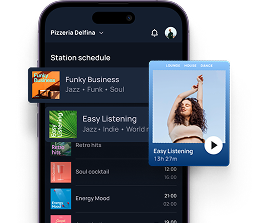How to Create a Waiter Job Description

Writing a clear and compelling server job description is one of the most important steps when you’re hiring for your dining team. It not only attracts the right candidates but also sets expectations about performance, culture and service. Crafted well, it becomes a tool for recruitment, training and ongoing excellence.
- Why the Role of the Server Matters
- Core Functions: What the Server Actually Does
- Building the Job Description: Key Sections to Include
- Skills & Attributes That Make a Star Server
- Compensation, Tips & Expectations
- Final Tips for Crafting & Using Your Job Description
- FAQ
Elevate your customer experience from the first note.
Get started in minutes with playlists tailored for your unique environment that are both unforgettable and fully licensed.

Why the Role of the Server Matters
When someone asks “what does a server do at a restaurant?”, the answer is far more nuanced than just “take orders”. A server is a front-line ambassador of your brand. According to industry insights, servers influence guest satisfaction, repeat visits and even word-of-mouth far more than many managers realise.
Imagine a diner arriving for a special evening out — the first person they meet is the server. That first handshake, greeting, or even acknowledgement sets the tone. When you draft a restaurant server job description, you’re essentially designing how your team will shape that first impression.
Core Functions: What the Server Actually Does
Here is a list of core functions that often appear in the best server descriptions:
- Greet and seat guests, present menus and inform about specials.
- Take food and drink orders accurately, including noting dietary restrictions or allergies.
- Collaborate with kitchen and bar staff to ensure correct, timely delivery of dishes.
- Monitor guests during service: check satisfaction, refill drinks, handle requests.
When you write out the duties and responsibilities of waiter roles, you must capture both observable tasks and less-tangible service moments.
- Process payments, issue itemised bills, handle cash or card transactions.
- Clear and reset tables, maintain dining area cleanliness and readiness for next seating.
- Upsell or suggest menu items when suitable (e.g., chef’s specials, dessert).
- Follow health & safety, sanitation and service standards—ensuring the guest experience and regulatory compliance.
Building the Job Description: Key Sections to Include
The logical format clarifies roles for future servers and supports your hiring process. To produce a professional restaurant server job description, structure your document into distinct sections: Job Summary, Responsibilities, Skills & Qualifications, and Working Conditions.
Job Summary
This opening paragraph should encapsulate the role’s purpose in your restaurant, for example: “We are seeking a motivated Server who will deliver exceptional dining experiences, support our floor team and drive guest satisfaction.”
Responsibilities
Here you’ll list in bullet form the day-to-day work (see list above) plus any specific elements unique to your concept—maybe mobile ordering tablets or wine pairings.
Working Conditions
Include a clear server job description that outlines shift expectations (nights, weekends), physical requirements (standing long periods, carrying trays), team-based environment, pace of service, and tips or bonuses—this helps set realistic expectations and attract candidates who thrive in fast-paced hospitality settings.
Skills & Qualifications
List the must-haves: strong communication, multi-tasking ability, cash-handling experience, menu knowledge, guest-oriented attitude. Also mention desirable traits like previous full-service experience or upselling skills.
Compensation & Opportunities
Optionally highlight hourly wage plus tips, growth path (Lead Server, Floor Manager) and any perks (meal discounts, flexible shifts).
By structuring the server job description this way, you help applicants understand exactly what you expect—and what they’ll receive in return.
Skills & Attributes That Make a Star Server
Beyond tasks, a standout server blends soft skills and personal traits with the operational mechanics of service. According to career analysis, the best servers combine speed, accuracy and empathy.
Here are some high-impact attributes:
- Active listener: hears guest cues before they speak.
- Menu expert: knows ingredients, preparation, recommendations.
- Multitasker: handles multiple tables, orders and guest needs simultaneously.
- Problem-solver: resolves issues smoothly (cold dish, drink spill, dietary request).
- Team-player: works with hosts, bar staff and kitchen to coordinate service.
When you craft your server job description, emphasise these as “Skills & Attributes” rather than mere tasks. It elevates the role from “order‐taker” to “experience creator”.
Compensation, Tips & Expectations
Let’s be transparent: servers often earn base pay plus tips, and your job description should reflect that so you attract serious, informed candidates. One recent report noted how compensation structures and shift patterns influence job satisfaction and retention.
You might include, for example: “Hourly wage $12 + tips (typical tip earnings $20-30 per shift). Must be available weekends and evenings.”
Setting clear expectations about server responsibilities, shifts and tipping helps filter candidates who are aligned with your model.
Server Role Performance Indicators
Below is a table that outlines measurable indicators you can use to monitor server performance and tie into training or reviews.
| Indicator | Why It Matters | Target / Notes |
| Average table turnover time | Impacts revenue and guest wait times | e.g., ≤ 1.5 hours in full-service restaurant |
| Sales per shift | Serves as a proxy for upselling & speed | Benchmark by season & concept |
| Guest satisfaction score / reviews | Reflects service quality & repeat business | Aim for ≥ 90% positive feedback |
| Order accuracy (%) | Reduces waste, complaints, and cost | Target ≥ 98% accuracy |
| Upsell ratio (dessert/drink add-ons) | Enhances per guest spend | Increase by 5–10% through suggestions |
Including this table in internal training or review meetings will reinforce the server responsibilities identified in your job description and help your team aim for shared standards.
Final Tips for Crafting & Using Your Job Description
- Use clear, engaging language: avoid industry jargon that might confuse candidates.
- Make your brand voice shine: mention what makes your restaurant special (mission, culture, cuisine).
- Be honest about requirements: heavy shifts, busy weekends—so candidates self-select.
- Keep it concise: one page plus bullet points helps readability.
- Include next steps: how to apply, what happens after submission, training timeline.
When you follow these steps, your waiter job description becomes more than a hiring tool—it becomes a blueprint for quality service, team culture and guest experience.
FAQ
Which server responsibilities are most overlooked during hiring?
Upselling, menu knowledge and teamwork are often overlooked. Many descriptions focus solely on taking and serving orders, but top performers also engage guests, recommend items and collaborate with the kitchen and bar.
What is the difference between a waiter job description and a server job description?
In many venues the terms “waiter” and “server” are interchangeable, but modern descriptions often prefer “server” because it emphasises service rather than just waiting tables. A well-crafted server job description reflects this shift, focusing on guest interaction, pace, and professionalism. The core tasks remain similar: greeting guests, taking orders, delivering food and processing payments.
What skills should I prioritise when evaluating applicants?
Look for communication, multitasking, guest-oriented mindset and resilience under pressure. Someone who can handle a busy shift while maintaining composure and service quality is a significant asset.
How do I set performance expectations for a server?
Use measurable indicators like average table turnover time, order accuracy, guest satisfaction and upsell ratio. Including such metrics in your job description or training documents helps servers understand what success looks like.
How detailed should a restaurant server job description be?
It should be detailed enough to set clear expectations (tasks, shifts, skills) but not so long that it overwhelms potential candidates. Include core server responsibilities such as greeting guests, taking orders, coordinating with kitchen staff, processing payments, and maintaining table cleanliness.


